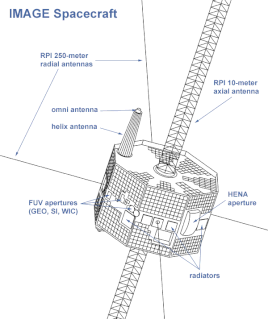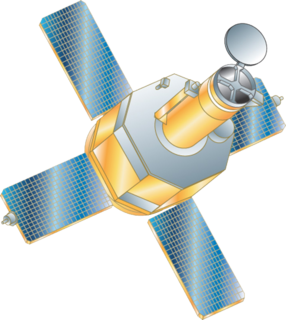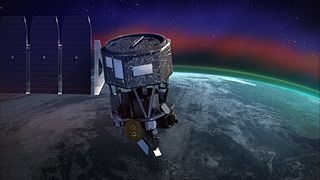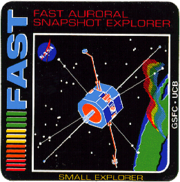
The Explorers Program is a United States space exploration program that provides flight opportunities for physics, geophysics, heliophysics, and astrophysics investigations from space. Launched in 1958, Explorer 1 was the first spacecraft of the United States to achieve orbit. Over 90 space missions have been launched since. Starting with Explorer 6, it has been operated by NASA, with regular collaboration with a variety of other institutions, including many international partners.

The Goddard Space Flight Center (GSFC) is a major NASA space research laboratory located approximately 6.5 miles (10.5 km) northeast of Washington, D.C. in Greenbelt, Maryland, United States. Established on May 1, 1959 as NASA's first space flight center, GSFC employs approximately 10,000 civil servants and contractors. It is one of ten major NASA field centers, named in recognition of American rocket propulsion pioneer Robert H. Goddard. GSFC is partially within the former Goddard census-designated place; it has a Greenbelt mailing address.

IMAGE is a NASA Medium Explorers mission that studied the global response of the Earth's magnetosphere to changes in the solar wind. It was believed lost but as of August 2018 might be recoverable. It was launched March 25, 2000 by a Delta II rocket from Vandenberg AFB on a two-year mission. Almost six years later, it unexpectedly ceased operations in December 2005 during its extended mission and was declared lost. The spacecraft was part of NASA's Sun-Earth Connections Program, and during its run had over 400 research articles published in peer-reviewed journals using its data. It had special cameras that provided various breakthroughs in understanding the dynamics of plasma around the Earth. The Principal Investigator was Jim Burch of the Southwest Research Institute.

Reuven Ramaty High Energy Solar Spectroscopic Imager was a NASA solar flare observatory. It was the sixth mission in the Small Explorer program (SMEX), selected in October 1997 and launched on 5 February 2002. Its primary mission was to explore the physics of particle acceleration and energy release in solar flares.

Transition Region and Coronal Explorer (TRACE) was a NASA heliophysics and solar observatory designed to investigate the connections between fine-scale magnetic fields and the associated plasma structures on the Sun by providing high resolution images and observation of the solar photosphere, the transition region, and the corona. A main focus of the TRACE instrument is the fine structure of coronal loops low in the solar atmosphere. TRACE is the fourth spacecraft in the Small Explorer program, launched on April 2, 1998, and obtained its last science image on 21 June 2010 23:56 UT.

The Space Sciences Laboratory (SSL) is an Organized Research Unit (ORU) of the University of California, Berkeley. Founded in 1959, the laboratory is located in the Berkeley Hills above the university campus. It has developed and continues to develop many projects in the space sciences, including the search for extraterrestrial life (SETI@home).

The Global Geospace Science (GGS) Wind satellite is a NASA science spacecraft launched on November 1, 1994, at 09:31 UTC, from launch pad 17B at Cape Canaveral Air Force Station (CCAFS) in Merritt Island, Florida, aboard a McDonnell Douglas Delta II 7925-10 rocket. Wind was designed and manufactured by Martin Marietta Astro Space Division in East Windsor, New Jersey. The satellite is a spin-stabilized cylindrical satellite with a diameter of 2.4 m and a height of 1.8 m.

The Time History of Events and Macroscale Interactions during Substorms (THEMIS) mission began in February 2007 as a constellation of five NASA satellites to study energy releases from Earth's magnetosphere known as substorms, magnetic phenomena that intensify auroras near Earth's poles. The name of the mission is an acronym alluding to the Titan Themis.

An electrically powered spacecraft propulsion system uses electrical, and possibly also magnetic fields, to change the velocity of a spacecraft. Most of these kinds of spacecraft propulsion systems work by electrically expelling propellant at high speed.

The Global Geospace Science (GGS) Polar satellite was a NASA science spacecraft designed to study the polar magnetosphere and aurorae. It was launched into orbit in February 1996, and continued operations until the program was terminated in April 2008. The spacecraft remains in orbit, though it is now inactive. Polar is the sister ship to GGS Wind.
Dynamics Explorer was a NASA mission, launched on August 3, 1981 and terminated on February 28, 1991. It consisted of two unmanned satellites, DE-1 and DE-2, whose purpose was to investigate the interactions between plasmas in the magnetosphere and those in the ionosphere. The two satellites were launched together into polar coplanar orbits, which allowed them to simultaneously observe the upper and lower parts of the atmosphere.

The Solar Anomalous and Magnetospheric Particle Explorer (SAMPEX) was a NASA solar and magnetospheric observatory, and was the first spacecraft in the Small Explorer program. It was launched into low Earth orbit on July 3, 1992, from Vandenberg Air Force Base aboard a Scout G-1 rocket. SAMPEX was an international collaboration between NASA of the United States and the Max Planck Institute for Extraterrestrial Physics of Germany.

C/NOFS, or Communications/Navigation Outage Forecasting System was an American satellite developed by the Air Force Research Laboratory Space Vehicles Directorate to investigate and forecast scintillations in the Earth's ionosphere. It was launched by an Orbital Sciences Corporation Pegasus-XL rocket at 17:01 GMT on 16 April 2008. It decayed on 28 November 2015.

The Magnetospheric Multiscale (MMS) Mission is a NASA robotic space mission to study the Earth's magnetosphere, using four identical spacecraft flying in a tetrahedral formation. The spacecraft were launched on 13 March 2015 at 02:44 UTC. The mission is designed to gather information about the microphysics of magnetic reconnection, energetic particle acceleration, and turbulence—processes that occur in many astrophysical plasmas. As of March 2020, the MMS spacecraft have enough fuel to remain operational until 2040.

The Interface Region Imaging Spectrograph (IRIS), also called Explorer 94, is a NASA solar observation satellite. The mission was funded through the Small Explorer program to investigate the physical conditions of the solar limb, particularly the chromosphere of the Sun. The spacecraft consists of a satellite bus and spectrometer built by the Lockheed Martin Solar and Astrophysics Laboratory (LMSAL), and a telescope provided by the Smithsonian Astrophysical Observatory. IRIS is operated by LMSAL and NASA's Ames Research Center.

The Ionospheric Connection Explorer (ICON) is a satellite designed to investigate changes in the ionosphere of Earth, the dynamic region high in our atmosphere where terrestrial weather from below meets space weather from above. ICON studies the interaction between Earth's weather systems and space weather driven by the Sun, and how this interaction drives turbulence in the upper atmosphere. It is hoped that a better understanding of this dynamic will mitigate its effects on communications, GPS signals, and technology in general. It is part of NASA's Explorers program and is operated by University of California, Berkeley's Space Sciences Laboratory.

RAX-2 is a CubeSat satellite built as a collaboration between SRI International and students at the University of Michigan College of Engineering. It is the second spacecraft in the RAX mission. The RAX-1 mission ended after approximately two months of operation due to a gradual degradation of the solar panels that ultimately resulted in a loss of power. RAX team members applied the lessons learned from RAX-1 to the design of a second flight unit, RAX-2, which performs the same mission concept of RAX-1 with improved bus performance and additional operational modes. Science measurements are enhanced through interactive experiments with high power ionospheric heaters where FAI will be generated on demand.

Explorer 43, also called as IMP-I and IMP 6, was a U.S. satellite launched as part of Explorers program. Explorer 43 was launched on March 13, 1971 from Cape Kennedy, with a Delta rocket. Explorer 43 was the sixth satellite of the Interplanetary Monitoring Platform.

Explorer 47, also known IMP-7 and Interplanetary Monitoring Platform IMP-H, was an American satellite launched as part of Explorers program. Explorer 47 as launched on 23 September 1972 on Cape Canaveral, Florida, U.S., with a Delta rocket. Explorer 47 was the seventh satellite of the Interplanetary Monitoring Platform.

Explorer 50, also known as IMP-J or IMP-8, was a NASA satellite launched to study the magnetosphere. It was the eighth and last in a series of the Interplanetary Monitoring Platform.




















